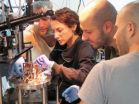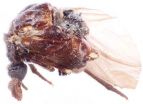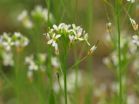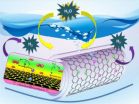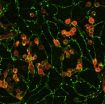(Press-News.org) Scientists at the University of East Anglia have shown how the main psychoactive ingredient in cannabis could reduce tumor growth in cancer patients.
Research published today reveals the existence of previously unknown signaling platforms which are responsible for the drug's success in shrinking tumours.
It is hoped that the findings could help develop a synthetic equivalent with anti-cancer properties.
The research was co-led with the Universidad Complutense de Madridin, Spain. The team used samples of human breast cancer cells to induce tumours in mice. They then targeted the tumours with doses of the cannabis compound THC (Tetrahydrocannabinol). They found that two cell receptors in particular were responsible for the drug's anti-tumour effects.
Dr Peter McCormick, from UEA's school of Pharmacy, said: "THC, the major active component of marijuana, has anti-cancer properties. This compound is known to act through a specific family of cell receptors called cannabinoid receptors. However, it was unclear which of these receptors were responsible for the anti-tumour effects of THC.
"We show that these effects are mediated via the joint interaction of CB2 and GPR55 - two members of the cannabinoid receptor family. Our findings help explain some of the well-known but still poorly understood effects of THC at low and high doses on tumour growth.
"There has been a great deal of interest in understanding the molecular mechanisms behind how marijuana, and specifically THC, influence cancer pathology.
"There has also been a drive in the pharmaceutical industry to create synthetic equivalents that might have anti-cancer properties.
"By identifying the receptors involved we have provided an important step towards the future development of therapeutics that can take advantage of the interactions we have discovered to reduce tumour growth."
Dr McCormick added that cancer sufferers should not be tempted to self-medicate.
"Our research uses an isolated chemical compound and using the correct concentration is vital. Cancer patients should not use cannabis to self-medicate, but I hope that our research will lead to a safe synthetic equivalent being available in the future."
'Targeting CB2 –GPR55 receptor heteromers modulates cancer cell signalling' is published in the Journal of Biological Chemistry.
INFORMATION:
UEA research reveals how cannabis compound could slow tumour growth
2014-07-14
ELSE PRESS RELEASES FROM THIS DATE:
The world's first photonic router
2014-07-14
Weizmann Institute scientists have demonstrated for the first time a photonic router – a quantum device based on a single atom that enables routing of single photons by single photons. This achievement, as reported in Science magazine, is another step toward overcoming the difficulties in building quantum computers.
At the core of the device is an atom that can switch between two states. The state is set just by sending a single particle of light – or photon – from the right or the left via an optical fiber. The atom, in response, then reflects or transmits the next incoming ...
Serendipity at the Smithsonian: The 107-year journey of the beetle Rhipidocyrtus muiri
2014-07-14
Serendipity leads University of Kansas scientists to the discovery and description of Rhipidocyrtus muiri - a 107 year old, lost in collections specimen, which turned out to represent a new genus and species. The long and tortuous history of the enigmatic ripidiine wedge beetle from Borneo is discussed in a recent paper published in the open access journal ZooKeys.
The holotype male, and only known specimen of Rhipidocyrtus muiri, was collected 107 years ago in Borneo but subsequent to this it was transferred among several researchers in the early 1900s. The specimen ...
Best for bees to be stay-at-homes
2014-07-14
Honey bees with roots in the local environment manage much better in the struggle for survival than imported honey bees from foreign environments.
A world without bees would be a whole lot poorer – literally. In Denmark alone an additional 600 million to 1 billion Danish kroner are earned annually due to the work done by bees making honey and pollinating a wide range of crops from apples to cherries and clover.
Unfortunately, bees all over the world are under pressure from pesticides, mites, viruses, bacteria, fungi and environmental changes, among other things. The ...
Molecular mechanisms underlying the prevention of autoim-munity by Roquin revealed
2014-07-14
The Roquin protein, discovered in 2005, controls T-cell activation and differentiation by regulating the expression of certain mRNAs. In doing so, it helps to guarantee immunological tolerance and prevents immune responses against the body's own structures that can lead to autoimmune disease. Roquin is thus an immune regulator. Autoimmune diseases affect between five and ten per cent of the population. They usually occur as a result of complex environmental influences when a genetic predisposition exists. Only in rare cases the development of the disease is determined by ...
Flower development in 3D: Timing is the key
2014-07-14
In close collaboration with Jürg Schönenberger and Yannick Städler from the Department of Botany and Biodiversity Research of the Faculty of Life Sciences, University of Vienna, 14 developmental stages of the flower of Arabidopsis thaliana from very early meristematic floral initiation to fully developed seeds were monitored with micro-computed tomography in 3D. From the same set of developmental stages a full metabolic profile using mass spectrometry was measured covering hundreds of biochemical pathways.
"Smallest changes in floral organ development were thus correlated ...
A-maize-ing double life of a genome
2014-07-14
Early maize farmers selected for genes that improved the harvesting of sunlight, a new detailed study of how plants use 'doubles' of their genomes reveals. The findings could help current efforts to improve existing crop varieties.
Oxford University researchers captured a 'genetic snapshot' of maize as it existed 10 million years ago when the plant made a double of its genome – a 'whole genome duplication' event. They then traced how maize evolved to use these 'copied' genes to cope with the pressures of domestication, which began around 12,000 years ago. They discovered ...
Rutgers chemists develop technology to produce clean-burning hydrogen fuel
2014-07-14
Rutgers researchers have developed a technology that could overcome a major cost barrier to make clean-burning hydrogen fuel – a fuel that could replace expensive and environmentally harmful fossil fuels.
The new technology is a novel catalyst that performs almost as well as cost-prohibitive platinum for so-called electrolysis reactions, which use electric currents to split water molecules into hydrogen and oxygen. The Rutgers technology is also far more efficient than less-expensive catalysts investigated to-date.
"Hydrogen has long been expected to play a vital role ...
Wisconsin scientists find genetic recipe to turn stem cells to blood
2014-07-14
MADISON, Wis. — The ability to reliably and safely make in the laboratory all of the different types of cells in human blood is one key step closer to reality.
Writing today in the journal Nature Communications, a group led by University of Wisconsin-Madison stem cell researcher Igor Slukvin reports the discovery of two genetic programs responsible for taking blank-slate stem cells and turning them into both red and the array of white cells that make up human blood.
The research is important because it identifies how nature itself makes blood products at the earliest ...
Testicular cancer rates are on the rise in young Hispanic Americans
2014-07-14
A new analysis has found that rates of testicular cancer have been rising dramatically in recent years among young Hispanic American men, but not among their non-Hispanic counterparts. Published early online in Cancer, a peer-reviewed journal of the American Cancer Society, the findings indicate that greater awareness is needed concerning the increasing risk of testicular cancer in Hispanic adolescents and young adults, and that research efforts are needed to determine the cause of this trend.
Testicular cancer is one of the most common types of cancer among adolescent ...
Potential Alzheimer's disease risk factor and risk reduction strategies become clearer
2014-07-14
COPENHAGEN – Participation in activities that promote mental activity, and moderate physical activity in middle age, may help protect against the development of Alzheimer's disease and dementia in later life, according to new research reported today at the Alzheimer's Association International Conference® 2014 (AAIC® 2014) in Copenhagen.
Research reported at AAIC 2014 also showed that sleep problems – especially when combined with post-traumatic stress disorder (PTSD) – may increase dementia risk in veterans. Additionally, in a population of people age 90 and older, ...
